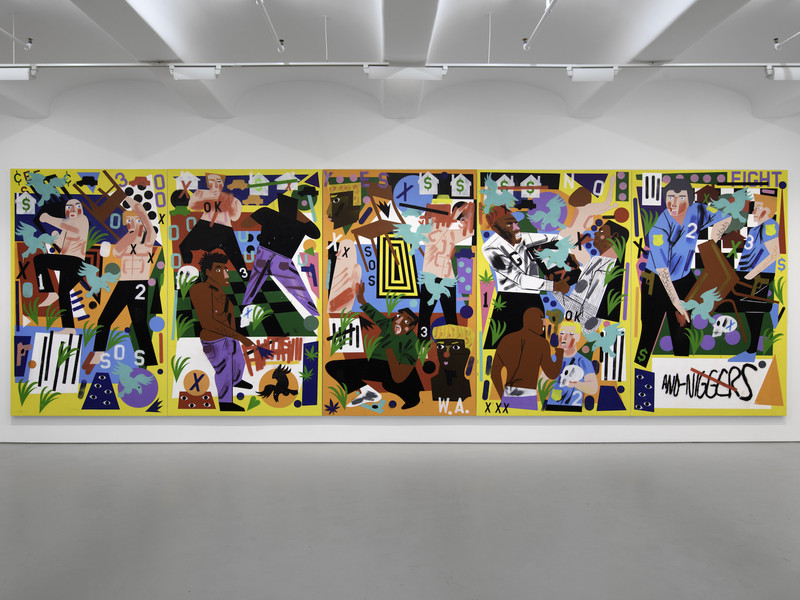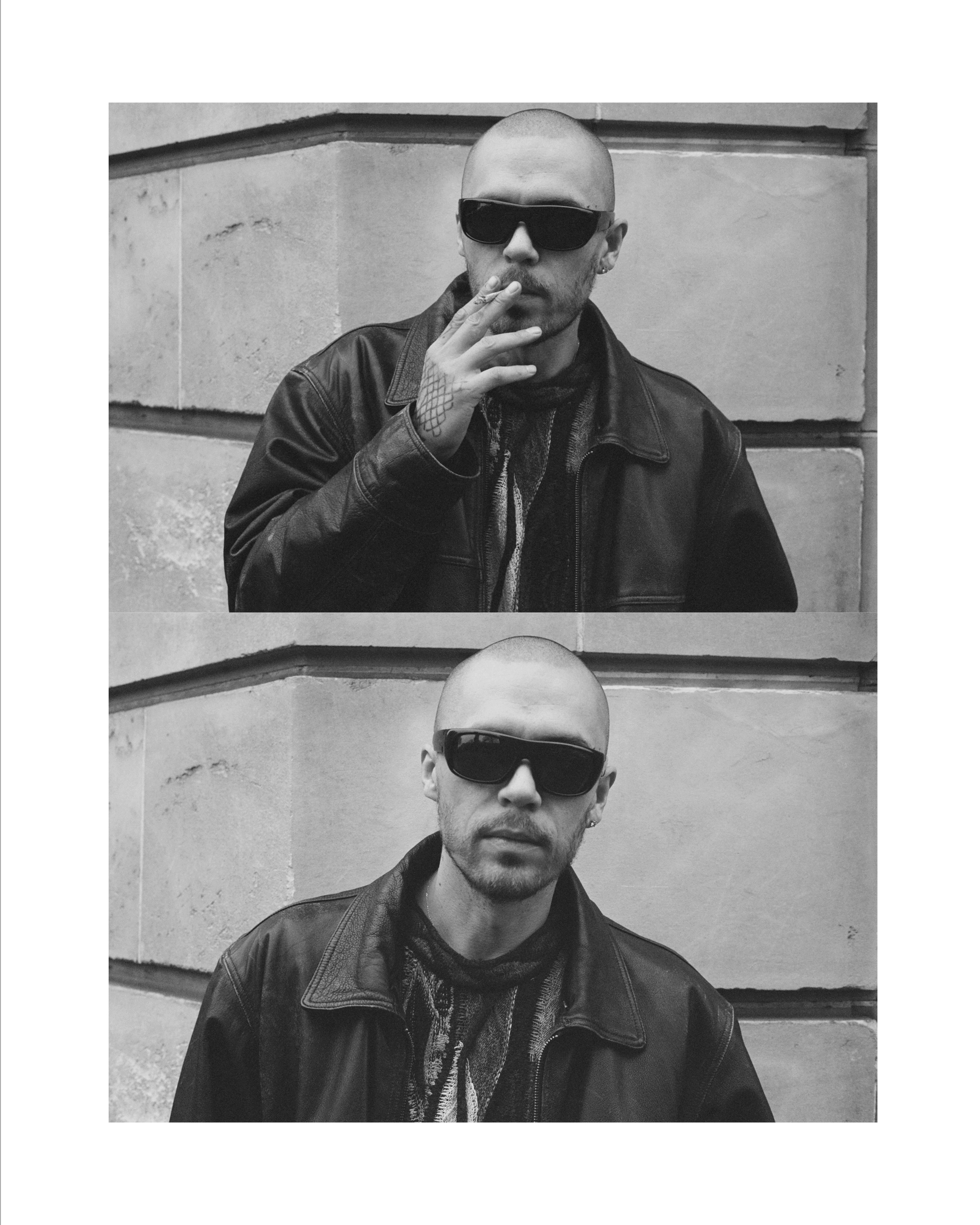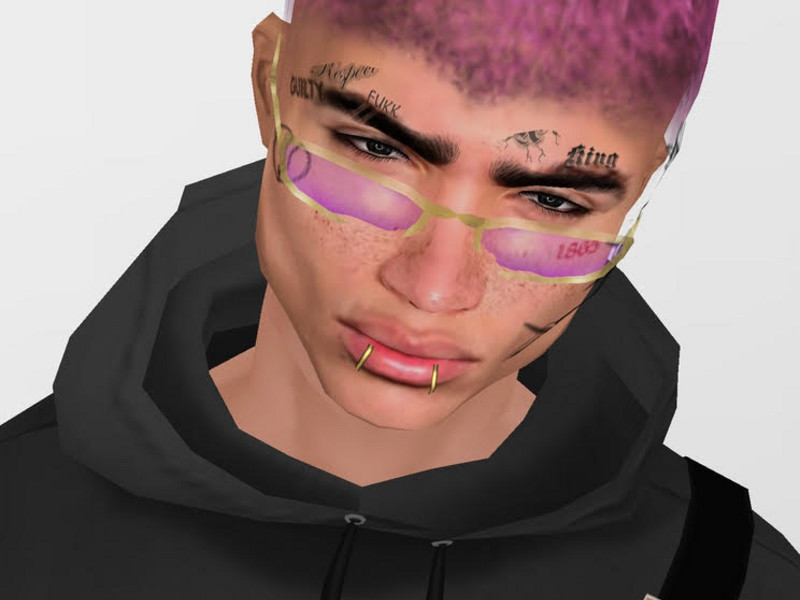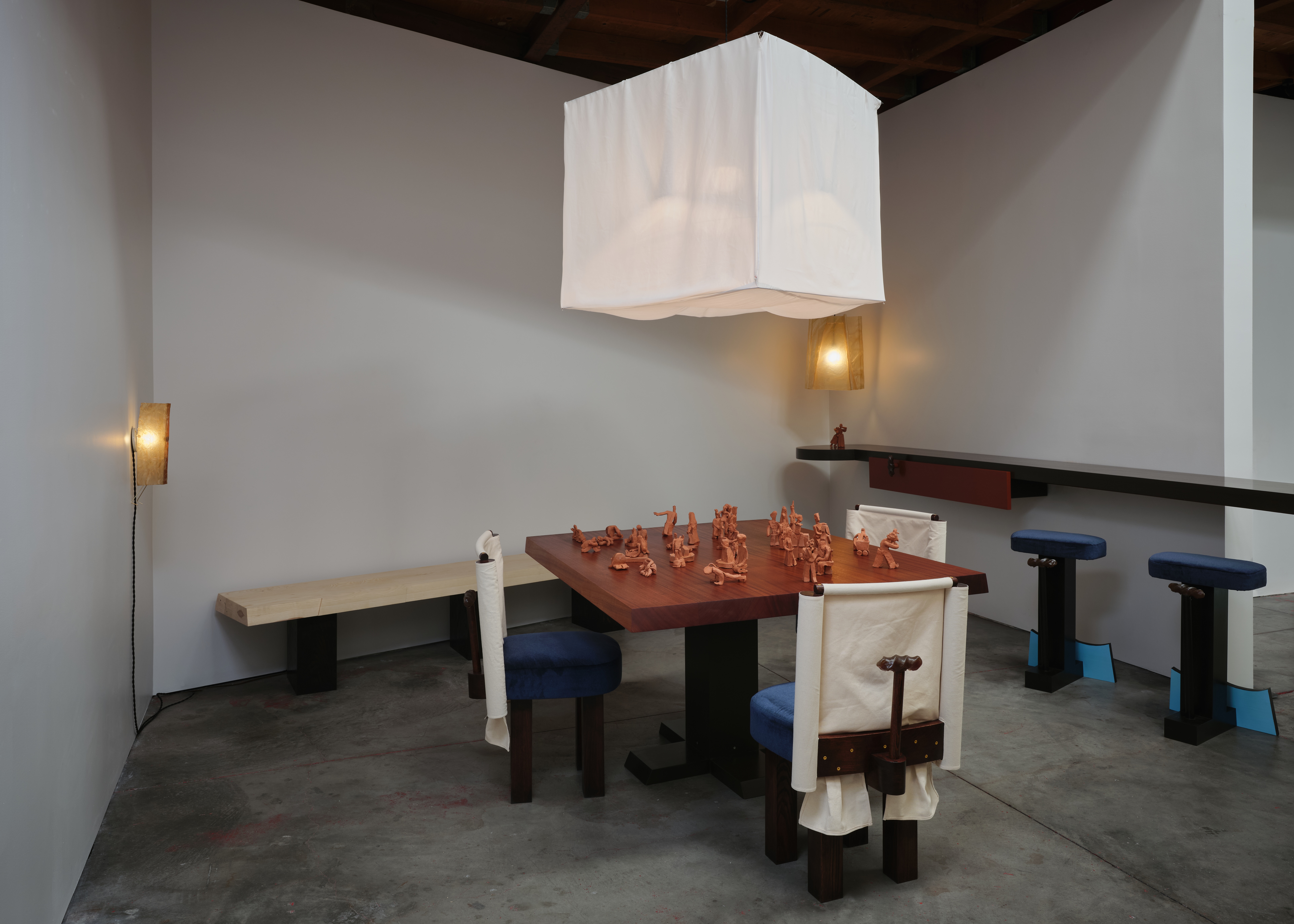Girls are Strange

The studio was similarly full of delightful odds and ends—a box full of mannequin hands here, a target from a firing range there. We sat amongst her pert and puzzling artworks for her upcoming show, Strange Girls, and after I turned off my recorder, chatted about her afro in high school and the wefts of hair she bought for the show and never used, which she displayed to me with a sense of experiment and awe. Read below to see how we ended up in this weird conversation.
So this show started with the piece, ‘Strange Girls’?
It started with that collage and drawing, yes. I have always made—well, you can see that my pieces are somewhat genderless, actually, yet some of them suggest to me male or female just in their attitude, the way they’re standing, not aggressively so, it’s in a way that you wouldn’t be able to say why. And that’s part of what I’m interested in, a fluidity throughout the work. It’s a fluidity about gender, about materials, you can’t really tell what is made of what—and that is part of what I really love to do. Most people look at my work and they think it’s wood or stone, no one thinks it’s clay.
That was going to be my next question—what is it made out of?
It’s carved clay. I work in a way that I think nobody else does—I work with the clay very hard. I’ve never made pottery—I’m not interested in pottery—I’ve always worked with clay as a material of sculpture. So, I carve it from the outside in and then the inside out. They’re all hollow, they’re all very light. It’s just a really beautiful, super expressive material, and also, as you can see, it’s like a chameleon.
Are the wall pieces made out of clay, as well?
No, they’re wood—but there’s clay on top of them. That’s the thing, you just can’t tell what is what.
I love the clock piece.
I was really into clocks for a while. This one is still going, here. Sometimes, I set the alarm for a random time, just to startle myself.
My mom had a wall of clocks like Gepetto’s cottage.
That is totally twisted! Do they go off all at the same time?
They’d be staggered—she likes clocks that play songs every hour. She’s really into coo-coo clocks, too.
Your mother is a performance artist! You’ll have to send her a photo of one of my clock pieces.
So, I work in all these different materials, like I was saying, and it’s very narrative, it’s very much about storytelling, but it doesn’t ever tell you—I hope—how to think. And what I like to do is set up the elements of a short story, and everybody who looks at it brings their own ending. So, you may ask me, ‘What’s that piece about?’ and I can tell you my story, but what’s more important to me is what you think—like, what story does this trigger in you?
They’re like little characters.
Yeah—they’re little people who live in my head.
You collect toys, and your works are kind of toy-like.
Well, when I was young, I actually thought I’d be a toy designer, and that’s why I started collecting them. I didn’t collect them to be a collector—I was really fascinated by the movements. When I think about this I blanche, but I actually used to take some of them apart to see how they were made. And then I realized, making art as toys is one thing, but commercial toy design is very different from what I’m interested in. But do I think of them as toys? No one has ever asked me that.
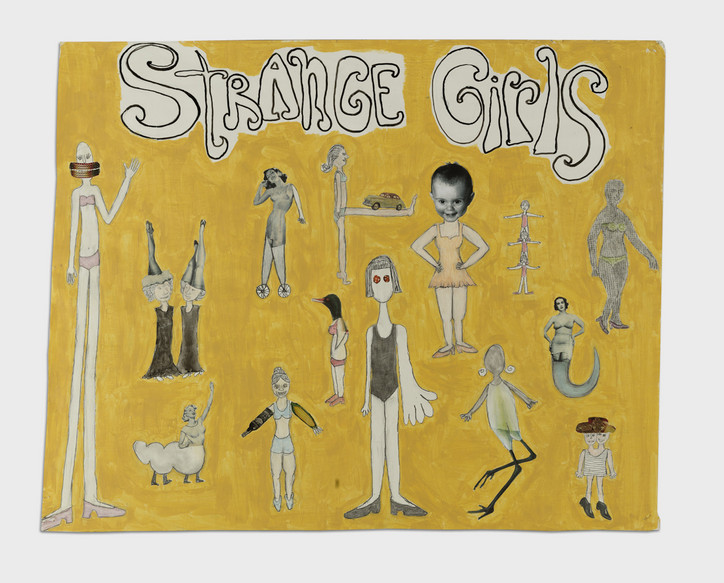

Above: 'Strange Girls,' 2009, and 'Gams,' 2017.
Well, they’re kind of like dolls.
They’re diminutive in size. I have made taller pieces. I’ve made pieces 6 and 8 feet tall—my rule is never to make anything heavier than I can carry myself.
Why?
Because I always want to be self-sufficient. Until I have staff, I never want to not be able to move or manipulate my piece myself without help. But I would be very willing to do something bigger—I mean, if somebody commissioned something. And I think all artists find their own scale. There’s a natural feeling of—I don’t know quite how to explain it, but it’s like, what is the scale that feels right for this idea? So, what you’re seeing here, the ones I did for this show, are on the same scale, but when you look around the studio there’s a lot of smaller pieces, a lot of different scaled pieces. I think of them as odd small people. Some of them are a little funny, but some of them are a little dark. There aren’t so many out here, but I have a lot of pieces that are missing limbs. But they’re all cheerful.
What happened to their limbs?
We don’t know! Right? Or I should say, ‘What do you think happened to their limbs?’ But the ones without limbs are the most cheerful—if I had to dig deeper, I would say it has to do with adversity. You may be a blue guy standing there with only one foot, but goddamnit, you’re going to smile.
But I love color, mixing materials together, found and fabricated objects—what I’m doing in this show is a slightly archaic form called assemblage, which is like collage but with three-dimensional objects. It doesn’t really fall into any niche, especially in the New York art world, people often don’t know where to put the work.
Because it’s sculptural and drawing at the same time, which is super fun.
Thank you! I did a stop-motion animation in a film, I was approached by an animation director who thought that my figures and my world would be pretty cool animated, and they were—it was some of the hardest work I’ve ever done. Stop-motion animation is insane. It’s so slow. It’s insanely slow.
Was it in clay, or?
No, it was drawing, and then we popped some of the figures into 3-D but they were made out of styrofoam, because that’s how you do it on a film set, and they’re more manipulatable. I’m really interested in these kinds of things—in people’s stories and memory.
What about childhood?
I was just going to say that. There’s a lot of echoes of things I remember from my own childhood. You know childhood is a very mixed experience. Years ago, I did a show called Back to School, and it was about your memories of school, and I remember working with school classes that came in, and I would ask all the kids, ‘What’s your most potent memory?’ and every kid had a memory of triumph. And then I asked the chaperones, and every adult had a memory of trauma or embarrassment—when I peed in my pants, or when the pigeon pooped on my head, etc. and I became very interested in that, where does it change? Where do you go from being that kid remembering the first time I mastered this and triumphed, to the adult who remembers the bad stuff?
Do you feel like that plays out in this show, as well?
Oh, absolutely.
It’s kind of a combination of positive and negative, there’s that sense of triumph, but also sort of sadness.
I think the things that people most commonly say is that the work is funny and dark at the same time.
Which is very much what childhood is.
Absolutely! And we all grew up on a very Disney-fied version, and then, I’m not going to say the underbelly is all dark, but it’s more complex.
I think even Disney gets kinda dark.
Old Disney, yeah. So, this piece is called The Green Room—I like titles that have multiple possibilities of meaning. So, she is in a green room.
I would never have guessed that as the title.
Really? What would you have guessed?
That’s funny that you ask me that because my friend and I played this game at the Noguchi museum where we would guess the titles.
I play the same game! I do it at museums.
I think maybe I would guess ‘Teeth’ for this one. I don’t know!
Well, I was thinking of celebrities or actors, for events, they always have to wait in the green room. And I always wondered why it’s called a green room. So that’s something in my memory where there’s the association of a color with waiting, so I’m digging into that. Also, I like titles that don’t hit you over the head too much. I like titles from old advertising. This piece is called ‘Four Out of Five Women Agree.’ Which also opens the door to so many ways to think about it.
So what about ‘Strange Girls,’ what about that title?
So, that big drawing came from a show I did years ago about circuses and sideshows, and I decided to make my own circus banners, and I have a couple of them—they’re huge, they’re paper mounted on canvas and they were all riffs on sideshow freaks. There’s one with a girl with no heart. They were all about women, because I always found, when I was doing research, the women in the sideshows were more interesting to me—the bearded lady, right? That’s really interesting. We know now that that woman probably just had a hormone problem. So I did these big banners. Then, for the very last one, I wanted to do a compendium of all the possible strange girls, like girls on wheels, girls with knives for arms. But then a lot of them are in bikinis, so it’s a push and pull between what girls are supposed to be and what girls actually are. By that I can extrapolate it to boys. Many men who I talk about the show with say, ‘Ugh, I’m a strange girl.’ It’s a little bit about feeling on the outside, less about what gender you are, and more about how you feel inside.
Everyone feels ostracized or weird at some point when you’re growing up, I think. And ‘Strange Girls’ almost reminds me of ‘Mean Girls,’ or the popular girl group.
There is a Mean Girls drawing in the show—my own version of Mean Girls. I did about six different versions and then one made it into the show.
Is there a love story going on? One of them is called 'First Date,' another 'Marriage.'
Yeah, of course. But I think love is ambivalent, people are ambivalent, relationships are ambivalent, they’re a push and a pull—even friendships, it’s a dance. Actually, I have a lot of pieces that refer to dance, one piece is called ‘First Position,’ because I think we all dance in relationships with each other.


Above: 'Partners,' and 'Pas de Deux,' 2011
There’s a potential for movement with a lot of the sculptures too.
Well, and I see a dance in the shapes in this one, in ‘Wig Shop.’
Especially with hair, there’s always the potential for movement.
I got a lot of hair things going on in this show.
Because it’s about girls?
It’s girls, and to be quite candid, I got really, really sick last year and as part of that I lost a lot of my hair, which has since has come back. And most of my figures for my entire career, as you can see, even though they could be girls, they never have had hair—ever. Horns or spikes maybe, or all sorts of things. But going through my own weird experience—losing your hair is fucking weird. But I’m fully healthy now! So, for the first time, I actually decided to look at hair and make it an element. And of course, there’s all these funny directions to go in with hair. The piece on the far left, the braid, is horse hair that I bought on the internet. The middle figure has metal scrubbies.
Yes, that one I recognized the material—which is funny, because I do hair and a lot of people will compare their hair to Brillo pads.
I’ve definitely had that in my life. So, then the one on the right is an iconic gesture—you can see that I’ve used for hair before, it’s partially because it refers to a hairstyle from the fifties, it’s like super-girl hair. So, I made that in three dimensions and that is rubber. So, part of the joke of that piece is that they have hair that could not possibly be hair—the objects I’ve used for their hair are not human hair.
That’s funny because, for me, as a hairdresser, sometimes people come in and they want something that’s not real. As a hairdresser, you’re constantly dealing with this magical realism in people’s minds before they go in and it’s like, 'I cannot do that.'
You’re an interesting person to talk to about this, because I am obsessed with eavesdropping at hair salons—obsessed. It’s mostly women, though I go to a salon that also has male clients. But I’m fascinated with the fantasies that people come in with about their hair and about who they are, let’s extrapolate that—how hair in a way is emblematic of your fantasy of yourself.
And your self-identity.
Absolutely. Hair is a form of identity.
Especially for women. I work primarily with men now, but I used to say that you’re not dealing with what’s on their head, you’re dealing with what’s in their head.
You just summed up everything about my work in that statement! It’s really about what’s in people’s heads.
Yeah, sometimes it’s like, what planet are you on?
It’s what planet are you on and who do you think you are—and I don’t mean that aggressively. So, I think it’s fair to say my work is pretty psychological, and yet at the same time, it’s funny—I think funny is legit. Often times, I think people are only comfortable pegging me one way or the other, that it’s either dark or it’s funny, but it’s both. It’s kind of like when people laugh when they’re nervous. It’s why people make that kind of humor—humor that is painful.
Cover image: 'The Green Room.' All images courtesy of Garvey|Simon.
'Strange Girls,' will be on view October 11 to November 11 at Garvey|Simon in NYC.









